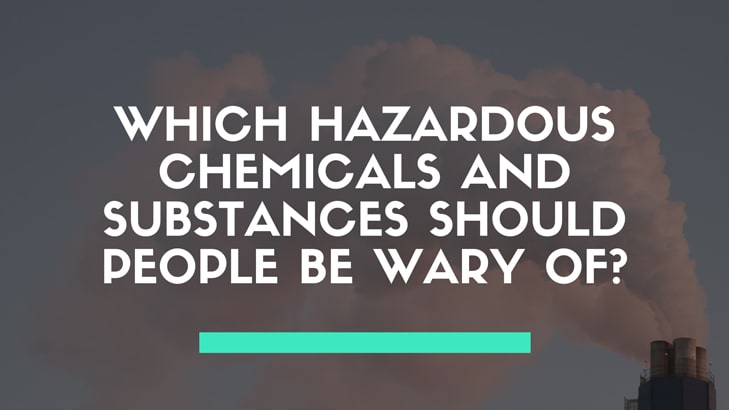Working in hazardous occupations involving chemicals that have significant health risks is an unavoidable reality in today’s world.
Unfortunately, poor safety measures and a lack of awareness contribute more frequently than we’d like to the occurrence of severe health issues.
This can be attributed to a variety of factors, such as insufficient training, a failure to prioritize safety, and a general lack of understanding regarding how dangerous specific chemicals can be.
In this article, we will focus on three common yet dangerous chemicals and substances that everyone should be wary of working with.
The Three Key Groups Of Hazardous Materials
There are many chemicals that pose dangers to humans, but certain chemicals stand out due to their extensive usage and severe health effects. These chemicals have the potential to inflict harm not just on individuals but on entire communities as well.
Whether it is due to their toxic nature, the potential for long-term health impacts, or the ease of exposure, they demand utmost precaution in handling.
1. Volatile Organic Compounds
Volatile Organic Compounds (VOCs) are characterized by their ability to evaporate at room temperature. They can be found in many workplace settings, such as:
- Manufacturing
- Construction
- Painting
- Cleaning operations.
Chemicals in VOC include:
- Ethylene
- Glycol
- Formaldehyde
- Methylene Chloride
- Xylene
- 1.3 Butadiene
- Perchloroethylene
Exposure to high levels of VOC chemicals can have detrimental effects on the health and well-being of workers. One notable incident that exemplifies the dangers of VOC exposure is the Camp Lejeune water contamination disaster.
This unfortunate disaster occurred at the Camp Lejeune Marine Corps Base in North Carolina. It turned out that the drinking water supply to the base was contaminated with VOCs for several decades. The main chemicals involved were trichloroethylene (TCE) and perchloroethylene (PCE), both commonly used VOCs.
Military personnel and civilian workers at Camp Lejeune were unknowingly exposed to these toxic chemicals through contaminated drinking water. The prolonged exposure to VOCs was soon linked to various adverse health effects. These included an increased risk of cancer, birth defects, and reproductive disorders.
The incident at Camp Lejeune serves as a tragic reminder of the potential harm that VOCs can inflict upon workers when proper safety measures and oversight are lacking.
Naturally, the incident led to a Camp Lejeune lawsuit situation as scores of people began to file for damages.
According to TorHoerman Law, LLC, more than a million people were affected by VOC exposure at Camp Lejeune between 1953 – 1987.
2. Hazardous Air Pollutants
Hazardous Air Pollutants (HAPs) are a group of toxic chemicals released into the air through industrial processes, combustion, and other activities.
According to the Environmental Protection Agency (EPA), there exist six main criteria for air pollutants:
- Carbon Monoxide
- Lead
- Nitrogen Oxides
- Ground-level Ozone
- Particle Pollution
- Sulfur Oxides
The EPA goes on to list several other hazardous pollutants, such as:
- Polycyclic Aromatic Hydrocarbons
- Total Petroleum Hydrocarbons
- Acrolein
- Asbestos
- Creosote
Exposure to these substances poses significant dangers to both workers and the general population. Exposure to HAPs can occur through inhalation, ingestion, or skin contact.
The dangers associated with HAPs vary depending on the specific chemical involved. However, common health effects include:
- Respiratory problems
- Neurological disorders
- Reproductive disorders
- Immune system suppression
- Cancer
HAPs may not seem as serious as some chemicals, but according to the World Health Organization and the International Labor Organization, exposure to HAPs is responsible for close to half a million deaths every year.
3. Chemical Solvents
Many chemical solvents can also pose harm to humans if not handled properly. These solvents are commonly used in industries such as manufacturing, cleaning, and laboratory work. As one can imagine, most of them wouldn’t fall into the “safe for human exposure” category.
Many of these solvents are also categorized as VOCs:
- Toluene
- Benzene
- Carbon Disulphide
- Carbon Tetrachloride
- Perchloroethylene (PCE)
- Methylene Chloride
- Ethylene Glycol
These solvents can cause a wide range of side effects to humans. Toluene, for example, is often seen in paints, adhesives, and cleaning agents. People exposed to Toluene for long periods often complain of dizziness and headaches. In severe cases, it has also led to nervous system damage.
Similarly, Perchloroethylene is known to be extremely hazardous and can cause kidney damage, CNS depression, and even death.
How Can People Working With These Chemicals Stay Safe?
While these chemicals are dangerous, they are also effective and essential to many industries. Rather than being afraid of them, it is more practical to learn how to work with them properly.
For starters, companies can ensure that all workers receive proper training on the specific chemicals they will be working with.
This includes:
- Basic understanding of chemicals and their properties
- Potential hazards, side-effects, and risks
- Safe handling procedures
- Emergency protocols.
Regular training updates should be provided to stay informed about the latest safety practices as well.
Workplaces that use dangerous substances need to monitor and test the environment regularly. This can ensure compliance with safety standards and detect potential leaks and exposure risks.
Good safety protocols would involve air monitoring, surface testing, or biological monitoring, depending on the nature of the chemicals used.
Conclusion
Continuously assessing the risks when working with dangerous chemicals is imperative. Sadly, many safety standards get lax in a natural manner. Many workers choose to work without PPE gear because it is more comfortable and convenient.
They may also experience peer pressure from other workers who mock them for following safety rules to the T.
The lack of enforcement of such regulations is one of the main reasons why hazardous disasters occur in the first place. Management in places where these chemicals are used should be held responsible. Ensuring proper enforcement of safety regulations when dealing with dangerous substances needs to be their number one priority.
